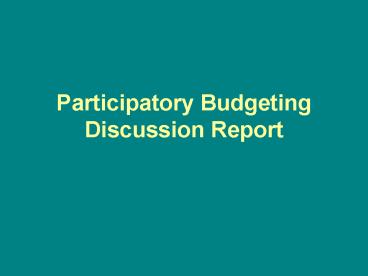Participatory Budgeting Discussion Report - PowerPoint PPT Presentation
1 / 14
Title:
Participatory Budgeting Discussion Report
Description:
HUNDEE has a project on Older Citizens at Sululeta Oromia. ... good experience on participatory budgeting at Anko ber woreda and Fogera Woreda. ... – PowerPoint PPT presentation
Number of Views:40
Avg rating:3.0/5.0
Title: Participatory Budgeting Discussion Report
1
Participatory Budgeting Discussion Report
2
Participatory Budgeting
- Outcomes and results that can be achieved through
SA. - Different Experiences on Participatory budgeting
3
Continue..
- It is possible to engage citizens in budget
cycle. It can be achieved through representatives
chosen by the community as a focal person. - At Beneshangul Region there is a project that
started before three years on participatory
budgeting.
4
Continue
- HUNDEE has a project on Older Citizens at
Sululeta Oromia. The project involves
participatory budgeting, implementation, and
follow up. - Remember the Poorest Community (RPC) has a
project on orphan and vulnerable children. It has
well organized committee with different parts of
community members (children, parents,
stakeholders and popular people). These group
follows each step in the budget process. - Amhara Region has good experience on
participatory budgeting at Anko ber woreda and
Fogera Woreda. In Fogera woreda the community
work on pointing out their problems, prioritize,
suggest on the solution. They involve in the
budgeting process. The service providers in
different sector as well report on quarterly base
to their respective desks.
5
Continue..
- From the experience of the above NGOs and GOs the
budget cycle (Ie) Preparation
Review, implementation, and follow up (M and E)
were dealt upon.
6
Continue.
- Benefits for citizens, Benefits gain government
intuitions or service providers. - It can address the core problem of a particular
community members - (youth, children etc).
- Encourages both providers as well as citizens
participatition. It is possible to obtain
community participation interms of labors,
material and finance. - Facilitate partnership with community members.
- Facilitate ownership and sustainability
- Youth and children can be empowered.
7
Continue
- Benefits for implementing organization (GO and
NGGs). - Accountability
- Transparency
- Efficiency
- Effectiveness
- Enables them to fulfill donors requirement.
8
Continue
- Key steps and tools of this approach and time
frame needed. - Involve community members particularly youth and
children in needs assessment - Prioritization of needs
- Involve them in budgeting
- Follow up and implementation
- Involve them in monitoring and Evaluation
9
Continue
- Tools
- PRA
- PRRP
- Opportunities for implementation in Ethiopia..
- Decentralization
- Youth and children policy
- CSOs interest
- Donors interest
- International Convention are in place
10
Continue.
- Challenges
- Current practice doesnt empower youth and
children - Budgetary problem
- Resistance to change
- Conceptual problem on budget cycle in general
- Frequent staff turn over of service providers
side - The community has less access for information
dissemination on social accountability. - The community has less knowledge on their right
to access information concerning budget.
11
Continue
- Messages for the plenary.
- GOs and NGOs need to involve citizens from the
inception of a project to end of the project
cycle. - GOs and NGOs need to address the voice of the
youth and children through participatory
budgeting cycle.
12
(No Transcript)
13
(No Transcript)
14
(No Transcript)































